When we talk about carbon neutrality, what are we talking about?
DATE:2021-10-28

Peak carbon: the process in which carbon emissions reach a peak and then cease to increase and gradually decline.
Carbon neutral: Refers to the fact that every object (global, national, enterprise or even a product, etc.) will "emit" the same amount of carbon as it will "absorb" in the future within a given period of time.
Carbon emissions lead to global climate change, human survival and development is facing a crisis global warming, the natural environment is threatened
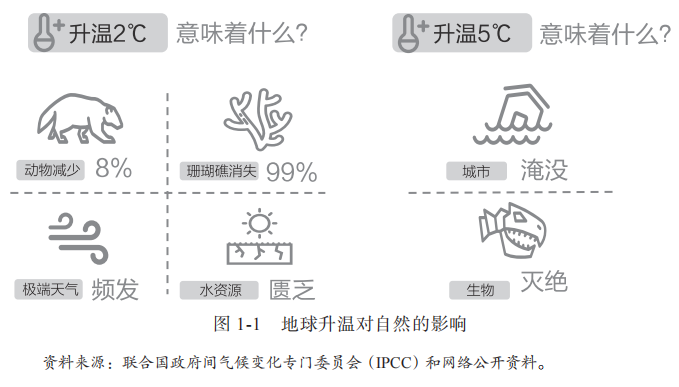
According to some studies, if the global average temperature rises by 5℃, the earth's entire environment will be completely destroyed, and there may even be a mass extinction of living things. As a result, every 1-degree Celsius increase in average temperature could have dire consequences for the planet (see Figure 1-1).
If the global average temperature rises by 2 ° C, 99 per cent of the world's coral reefs will disappear, permafrost close to the size of Mexico will thaw permanently and water resources will be severely strained. Earth's year-round climate has remained stable for thousands of years. Like our bodies, the Earth regulates itself to maintain a dynamic climate balance, which is one of the most important features of an ecosystem. Once the internal ecological balance of the earth's ecosystem is broken, it will cause irreversible effects on the environment.
The main culprit of global warming is carbon dioxide and other greenhouse gases emitted by human activities. Greenhouse gases mainly include water vapor, carbon dioxide, nitrous oxide, freon, methane and so on. These gases enhance the insulating effect of the atmosphere, thus raising the global temperature.
The Paris Agreement sets a target for controlling the rise in global average temperature
In order to jointly address The challenge of climate change and mitigate The trend of global warming, nearly 200 parties adopted The Paris Agreement in December 2015, setting out The post-2020 action plan for The global response to climate change. The main objective of the agreement is to limit the rise in global temperatures in the 21st century to 2 ° C above pre-industrial levels, and to seek to limit the rise further to 1.5 ° C (see Figure 1-2)
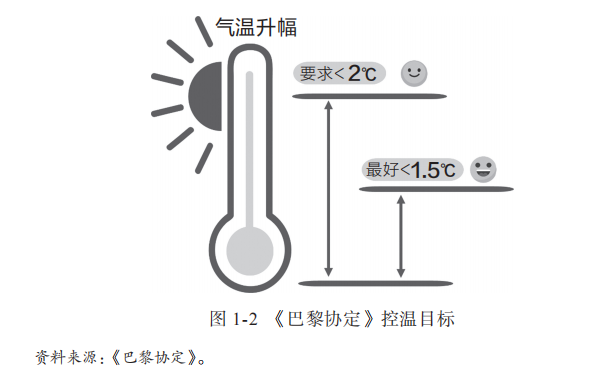
Why try to keep it under 1.5℃? According to the IPCC Special Report on Global Warming of 1.5 ° C released by the Intergovernmental Panel on Climate Change, if the global temperature rise is controlled within 1.5 ° C, a large number of losses and risks caused by climate change will be avoided, for example, millions of people will be prevented from falling into poverty caused by climate risk. Reduce by half the proportion of the global population affected by water stress, reduce the frequency of extreme weather events such as heavy rainfall and drought, and reduce the negative impact on fishing and animal husbandry.
Every energy conversion of human beings contains inestimable value.
In Climate Economics and the Future, Bill Gates says there are two numbers you need to know about climate change: the first is 51 billion, and the second is zero. 51 billion is the approximate tonnage of greenhouse gases the world emits into the atmosphere every year. "0" is the goal we need to achieve.
As the world's second largest economy and the largest emitter of CARBON dioxide, China has announced the goal of carbon neutrality, actively responded to the Paris Agreement on climate change, and made a proactive commitment to reduce emissions.
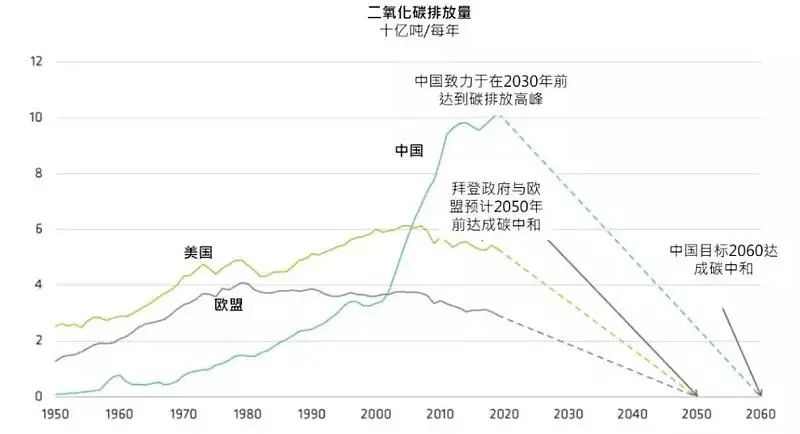
Image credit: Goldman Sachs, Our World in Data UBS and AllianceBernstein
According to China's "30 · 60" dual carbon target, China needs to achieve "carbon peak" by 2030, that is, carbon emissions peak after no increase, and "carbon neutral" by 2060, that is, the amount of carbon emitted equals the amount of carbon absorbed.
On the way to "carbon neutrality", China's energy structure, industrial structure, energy application efficiency and green technology innovation will have extensive and far-reaching changes, which have also become the focus of the recent capital market. From a long-term perspective, carbon neutrality is a sea of stars, and investment in related themes has just begun.
At the beginning of this year, the state included "carbon peak and carbon neutral work" as key tasks in the first year of the 14th Five-Year Plan. Positive factors were quickly transmitted in the capital market and in the secondary market. Carbon neutral "concept stocks have already become a shining star, a stock because of the" carbon neutral "concept, even pulled 21 daily limit, photovoltaic, hydrogen, new energy and other benefits, and the primary market, according to the statistics of Euro think tank, only half a year's investment scale reached a record high (40.529 billion yuan)," Demand exceeds supply. 2021 is also known as the "first year of carbon neutrality".

In the next 40 years, the adjustment of economic growth pattern, industrial structure, energy structure, consumption pattern, lifestyle and ecological construction will all be affected by this.
What are the opportunities in carbon neutrality? The construction of green and low-carbon circular development system requires the coordinated transformation of production system, flow system and consumption system.
Industry transformation path map
From the perspectives of energy supply side and energy demand side, we imagine the "zero carbon" future of electric power, non-electric power, steel, cement, chemical industry, transportation, construction and service industries according to the characteristics and development status of the industries, and propose specific decarbonization paths for each industry (see Figure 3-1). We believe that in the process of energy saving and emission reduction, all industries cannot do without the development of carbon "negative emission" technology, the construction of carbon emission trading system and the guarantee of green financial system. Therefore, these supporting factors should be vigorously developed when the industry starts to reduce emissions.
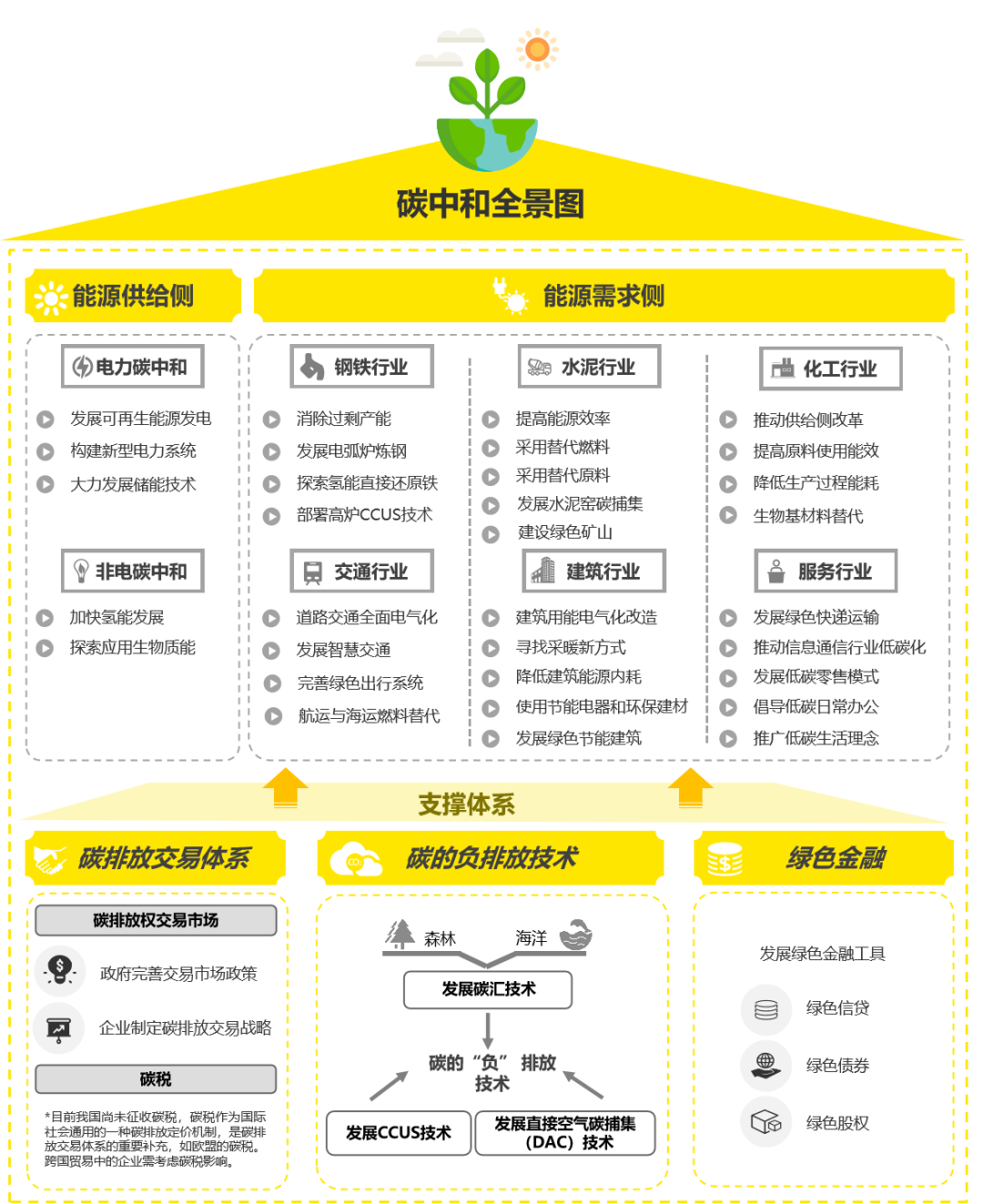
What's the next step in achieving carbon neutrality
Advice to businesses
(1) Know your own "carbon background" and define the range of carbon emissions
An important basis for enterprises to achieve carbon neutrality is to make clear their carbon emissions within the scope of production and operation, and to do a good job in carbon emission accounting is the basis for enterprises to carry out carbon neutrality work.
The Greenhouse Gas Protocol, developed by The World Resources Institute (WRI) and The World Business Council for Sustainable Development (WBCSD), divides corporate carbon emissions into ranges 1, 2 and 3.
Range 1 refers to the emissions of enterprises' own facilities, such as raw material production and processing in the manufacturing industry and fuel burning in the energy industry. Range 2 is the emissions of power supply institutions caused by enterprises' consumption of outsourced energy, such as the emissions generated by enterprises' outsourced power and steam, represented by the Internet technology industry -- the outsourced power of data centers; Range 3 refers to all other emissions, including the carbon emissions of purchased goods and services, upstream and downstream industrial chains, and the use process of sold products, such as employee travel, upstream and downstream transportation, distribution and leasing assets.
(2) On the basis of clarifying the emission range, enterprises need to clarify the total amount of emissions, that is, carry out carbon accounting
There are two international standard accounting methods for enterprise carbon accounting and evaluation analysis. The first method is based on ISO 14064 standard, such as enterprise carbon verification, which is to calculate the total annual carbon emissions of enterprises, including only the emissions in range 1 and 2. This method is often used in the carbon emission trading and carbon emission reduction verification of enterprises. Figure 4-1 shows the calculation of the total amount of carbon dioxide equivalent emitted by an enterprise according to ISO 14064.
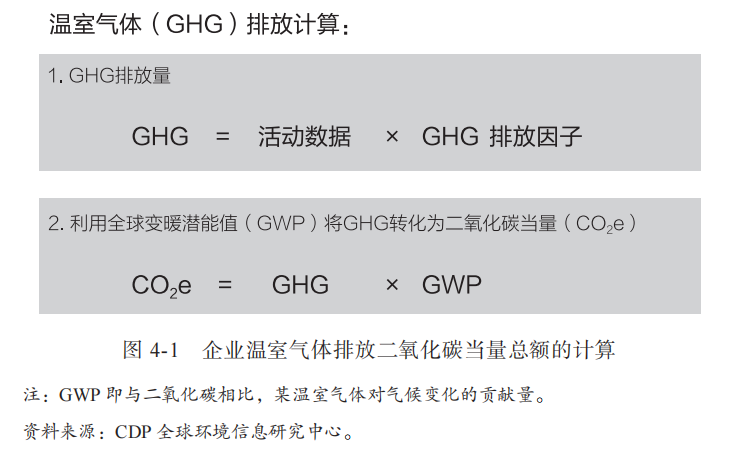
The second method is based on ISO 14067 standard. This method not only counts the emissions in range 1 and 2, but also the emissions in range 3, which can be used to measure the carbon emissions of technical solutions for low carbon technology research and development and comparative evaluation, but also to measure the carbon footprint of enterprises for carbon peak and carbon neutrality accounting. The first method is easy to calculate and verify, while the second method involves the whole process of the supply chain emissions, which is difficult to accurately calculate. However, if accounting according to the first method, the vast majority of enterprises do not have a large amount of direct carbon emissions, unable to meet the threshold of carbon emission trading market, enterprises are difficult to improve, limit the play of emission reduction potential. Therefore, for most enterprises that are not directly high in carbon emissions, it is suggested to adopt the second accounting method to measure the carbon emission level of the whole value chain. At the same time, enterprises can also consider combining emerging technologies and digital solutions, such as big data, artificial intelligence, machine learning, etc., to improve the accuracy and reliability of carbon emission statistics, and should regularly disclose the progress of carbon footprint information.
(3) Formulate scientific carbon emission reduction targets based on the characteristics of enterprises
After calculating the total carbon emission of the current enterprise, the enterprise should make its own carbon emission reduction targets and plans based on its own business characteristics and combined with China's "30·60" double carbon target, and release its own carbon peak and carbon neutral schedule.
When setting carbon reduction targets, companies can refer to the guidance published by the Science Based Target Initiative (SBTI) to set scientific carbon targets in line with the Paris Agreement.
(4) Formulate a concrete roadmap for action
Specific emission reduction implementation path is the premise to ensure the realization of each key time node target.
How should enterprises integrate specific emission reduction actions into production operations? By analysing the actions of leading European companies to reduce emissions, we have come up with some suggestions for how to do so. First of all, establish enterprise-level emission reduction project team, led by senior management of the company, to more effectively promote emission reduction action, and regularly review the emission reduction results of various departments. Secondly, the company's emission reduction targets and road maps are refined into emission reduction targets and road maps of all departments, and the emission reduction targets are included in the department head assessment system, and the Environment key performance indicators (E-KPI) are set up to improve the enthusiasm of emission reduction in all internal operation links. Finally, the "carbon tax" of the company is established. The cost of the carbon tax is included in the calculation of simulated profits through the establishment of a simulated market in the internal transaction of the company, so that all departments take the initiative to undertake the responsibility of reducing carbon emissions. For example, in 2012, a large group began to implement a carbon tax accountability system, in which departments are required to pay a certain carbon tax ($15 per ton) when they use internal high-carbon products or services. These carbon taxes will not only affect the profits of the department, but also all departments need to pay the "real money" of the carbon tax to the headquarters of the group to form a special carbon emission reduction fund for the research and development of low-carbon technologies.
(5) "core emission reduction" is the focus, developing and cultivating low-carbon technologies
Achieving carbon neutrality means making deep adjustments in the energy mix and industrial structure, rather than relying too much on carbon offsets such as afforestation. Because of forest planting area and land area is limited, so our country can develop and utilize the carbon offsets "lines" is limited, that is to say, although NbS can carbon to a certain extent, help to achieve carbon neutral, but it's not a "tiger balm", improve the proportion of renewable energy utilization, get rid of the dependence on fossil fuels is the focus of enterprise carbon emissions. This requires enterprises to focus on their core business, increase r&d and investment in process and technology, expand low-carbon transformation solutions, and ensure continuous innovation and upgrading of technology. Enterprises can choose to cooperate with research institutions and experts to jointly study "core emission reduction" technologies. In addition to reducing the carbon emissions of internal core businesses, research on "negative emission" technologies such as carbon capture should be increased to reduce the green premium of enterprises. Technology is an important part of the track for enterprises to achieve carbon neutrality. The enterprises that take the lead in mastering advanced technology will lead the industry to achieve low-carbon and win-win benefits. For different industries, the above mentioned technologies should be focused on to achieve energy conservation and emission reduction. For example, the power industry should develop renewable energy-based power generation technologies and build new power systems. Iron and steel, cement and other industrial industries through the substitution of raw materials, fuel, depth of industrial electrification, the use of industrial waste heat recovery, vigorously develop CCUS technology. Companies need to face up to the challenge of reducing carbon emissions and truly commit to carbon neutrality, rather than risk greenwashing themselves by relying disproportionately on NbS.
(6) Establish a carbon neutral management system for the whole supply chain
At present, some advanced enterprises have carried out the carbon emission reduction work of the whole supply chain, and require the person in charge of the supply chain management department to join the carbon emission reduction project team, and take low-carbon environmental protection as one of the indicators of supplier selection. For example, a technology company has done a supply chain carbon emission survey on every product for more than a decade and published the results of the product's carbon footprint. In addition, some manufacturing enterprises include the carbon emission index of materials upstream of the supply chain into the assessment and evaluation of suppliers, providing decision-making basis for enterprises to choose suppliers. Others set annual emissions-reduction targets with each of their key suppliers and review at the end of the year whether they have met the targets set at the beginning of the year and incorporate the results into the next year's supplier selection criteria.
(7) Using digital transformation to empower
At present, the construction of smart cities, smart energy, smart transportation, smart factories and smart buildings is a powerful starting point for comprehensively carrying out the carbon emission reduction campaign and realizing carbon neutrality, and the smart "starting point" cannot be separated from the empowerment of digital technology. For enterprises, digital technological innovation is the core driving force for new drivers of enterprise development, which can bring new links, new processes, new businesses and new forms of business. The low-carbon development path of enterprises cannot be separated from digital transformation.
(8) Focus on carbon risk management and information disclosure
Faced with a choice of similar products, consumers are more inclined to choose products from companies with high business transparency and proactive disclosure of their impact on people and the planet. To some extent, this will stimulate enterprises to make transparent and sustainable information disclosure, so as to enhance product competitiveness. Under the goal of carbon neutrality, enterprises, as the main body of carbon emissions, are more responsible for high-level carbon risk management and high-quality information disclosure. Enterprises should establish their own carbon risk management system, systematically assess carbon risk, take the combination of proactive prevention, control, compensation, undertaking and opportunity transformation to carry out carbon risk management, and regularly update the carbon risk management system, including carbon risk management and carbon compliance.
(9)Assess the cost of carbon reduction and address the economic impact of carbon tariffs
Carbon tariffs will increase the cost of export enterprises, deprive some enterprises with high carbon emissions of their original cost advantages, and change the industry competition pattern. Industries such as coke, refined petroleum products, mining and quarrying will be directly affected by the EU's proposed "Carbon border Regulation Mechanism" in March 2021. Due to the large carbon emissions of China's steel enterprises, exports to the EU need to pay high carbon tax, and high carbon efficiency of foreign steel enterprises to pay taxes and fees will be 50% less than China's steel enterprises, so compared with other countries with less carbon emissions of steel enterprises, China's steel enterprises will lose the cost advantage. On one hand in order to reduce the influence of carbon tariffs, the enterprises should actively the implementation of green low carbon development policy, on the other hand to timely understand the latest trend of national policy, assess the carbon cost, the carbon costs into business decisions, in a timely manner to measure the carbon price's influence on the products and other related costs, and will be included in the offer of the cost of management accounting reports.
Carbon removal technology & Carbon removal cloud
——Professional provide enterprise double carbon consulting and solutions!

LASTER NEWS
Media interview on carbon cleaning technology
2022-03-23European Commission approves Carbon Boundary Regulation Mechanism (CBAM)
2022-03-18[News] Carbon technology was invited to attend the carbon Peak carbon neutralization work symposium
2022-03-04[Review of the first year of the National Carbon Trading Market]
2022-03-18"Clean Carbon Technology" was invited to conduct professional training on double carbon for the League of Nations Group
2021-12-23COP26 -- The best time and the last chance!
2021-11-12Support for the
2021-10-19Enabling a zero-carbon future
2021-10-15Carbon removal technology helped wuxi Bureau of Ecology and Environment "tin carbon walk" activities
2022-02-26"Clean Carbon Technology" was invited to conduct professional training on double carbon for the League of Nations Group
2022-03-08




 苏公网安备31010702002557号
苏公网安备31010702002557号